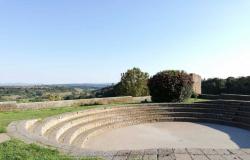On February 1, 1920, crossing the Gulf of Finland on foot on the ice, the young architect and painter Andrej Beloborodov fled Petrograd after a brief collaboration with the Bolshevik government at the Hermitage. He trained in Petersburg as a promising artist, whose works are exhibited in the Bobrinsky Palace, the Imperial Cabinet in the Anikov Palace, the Palace of Prince Yusupov. The escape, apart from the difficult relations with the new Soviet power, was motivated by the aspiration to see Italy and visit Rome, from which he had been kept away from the outbreak of the Great War, despite having received a scholarship from the Academy Russian Fine Arts.
The escape was followed by a long pilgrimage, which took Beloborodov first to London, where he stayed with the famous dancer Anna Pavlova, then to Paris, where he was successful as a landscape painter and from where he was able to travel to Italy every year until his final move in 1934. fate thus brought to fruition the painter’s aspiration to reunite with that Palladian ideal of harmony and measure, which he had always chosen as his ideal. Giorgio de Chirico, in reviewing a Roman exhibition of Beloborodov, wrote that he had returned «to his world. A profoundly Mediterranean world.” A volume dedicated to him is now out, edited by Andrej Shishkin and Olga Strada Andrea Beloborodov Rome and the Roman villas (Valore Italiano editore, pp. 127, euro 38.00) which offers thirty-six reproductions (presented in Italian, English and French), along a narrative itinerary commented by the Franco-Russian writer Jean Neuvecelle (Dmitrij Ivanov, son of the famous symbolist poet Vjaeslav ) reconstructing the spirit of Beloborodov’s Rome and providing at the same time some specific traits of the places described and how they appeared before the demolitions carried out by fascist urban planning (for example, the demolition of the Spina di Borgo): from the Obelisk of San Pietro to the Roman Forum, from the Marcellus Theater to the villas of Caprarola and Bagnaia.
In this, as in many other pictorial cycles (the artist dedicated some to Venice, Florence, Pienza, Montepulciano, Naples, and other cities), Beloborodov’s landscape painting tends to develop into a personal and original vision, a sort of “metaphysics Palladian”, as de Chirico wrote. Landscapes devoid of human presence seem to be characterized by transparency and silent lightness.
In commenting on another work by Beloborodov, The Big Island, Corrado Alvaro recognized in it «a universe created by men, once all the combinations have been exhausted, put into a bag, shuffled, overturned, similar to a gigantic game of dice on which the ‘question of civilization and the stakes of the future’. In France Beloborodoff was appreciated by many artists and writers, so much so that Paul Valéry wrote the preface for a collector’s edition of Le Golfe de Salerne. In Rome Beloborodov held a celebrated exhibition of views of the city and Italy in November 1934, and linked himself to the Swiss writer and philanthropist Maurice Sandoz, his client and for whom he designed the Villa San. This association is linked to Beloborodov’s meetings with Dalì, Praz and de Chirico. Lively active in the Italian cultural life of the time, the painter also designed the scenarios for Goffredo Alessandrini’s successful cinema We live – Goodbye Kira (1942), set in Soviet Russia and starring Alida Valli and Fosco Giachetti.






